-

人教版高中英语必修5Life in the Future说课稿5篇
Good afternoon, everyone. It’s my great pleasure to be here sharing my lesson with you. The content of my lesson is Senior English for China Book5 Unit 3 Life in the Future. I’ll be ready to begin this lesson from six parts: Analysis of the teaching material, Analysis of the students, Teaching aims and important and difficult points, Teaching methods and aids, Teaching procedures, and Blackboard design. First, let me talk about the teaching material.Part 1 Analysis of the Teaching Material:This unit is about what human beings’ life will be like in about one thousand years. By studying of this unit, we’ll Enable the students to know the changes in humans’ life and some new inventions bringing about the change and develop the interest in science. This lesson plays an important part in the English teaching in this unit. This is an important lesson in Book Five. From this lesson, it starts asking the Ss to grasp contents of each passage. Therefore, this lesson is in the important position of the teaching material. If the Ss can learn it well, it will be helpful to make the Ss learn the rest of this unit.Part 2 Analysis of the SsAs Senior2 Ss, they are at different levels of English fluency, some of them have lost interest in English. So during the lesson, I arrange a variety of activities to let all of them join in to attract their interest and let them be confident and taste the joy of success.

人教版高中英语必修5Making the news说课稿4篇
今天我们来介绍一下必修五第四单元的授课方式。这个单元的题目是Making the news。应该是学生比较感兴趣的话题,学生往往对新闻工作充满好奇,所以我们可以利用这个机会多设计一些师生互动和学生互动,来激发起学习的积极性,提高学习效率。同时我们可以利用这个单元不仅帮助学生掌握语言知识,培养语言能力,同时让其了解新闻工作的重要性,培养起社会智能感。这个单元分为六个课时,它的教学目标是这样的:语言目标是掌握词汇表中的常用单词和短语,掌握倒装句的一些基本用法。 技能目标是能初步掌握约会的基本句型并在真实的场景下正确运用。新闻报道类文章的写作技能。采访的基本规范和沟通技能。情感目标是对新闻报道的客观性和真实性有更好的理解。对新闻记者的职业有更深入的了解,并能体会其工作的重要性。下面我们来介绍一下第一课时的授课方式,第一课的教学目标是这样的第一课时的教学目标语言目标:单词:Occupation, journalist, editor, photographer, curious, personality, enthusiasm

人教版高中英语必修5The United Kingdom说课稿4篇
Teaching Aims:Knowledge 1. Get the students to learn the useful new words and expressions in this section. Aims:2. Let the students learn about how the UK was formed and the four groups of invaders.1. Develop students’ reading ability and let them learn different Ability reading skills. Aims:2. Enable students to learn to talk about the United Kingdom and the Union Jack Emotional 1. Let students know more about the UK2. Develop students’ sense of cooperative learning Aims:Teaching Important Points:1. Let the students learn about the countries of the United Kingdom and the Union Jack2. Get the students to read the passage and know about how the UK was formed and the four groups of invaders.3. Have the students learn different reading skills.Teaching Difficult Ponts:1. Develop students’ reading ability.2. Enable students to talk about the United Kingdom and the Union Jack.3. Let students learn how the UK was formed geographically and historically.Teaching Methods:Showing pictures, asking, exercising, listening, reading etc.Teaching Aids:A computer,a projector and a blackboard.Teaching Procedures: 1) Show a map of the world, ask students the following questions:Where is the UK?What’s the full name of the UK?2) Ask the students work in pairs to do the quiz on Page 9.Do you want to test how many things you know about the United Kingdom? Let’s have a small test.Using the map on P9, students answer the following questions:?How many countries does the UK consist of? What are they??England is divided into three main areas. Do you know what they are? 1) Scanning (10Minutes )Let the students hold the questions asked in pre-reading and read the passagequickly and then let them do the following exercise.Join lines to the right answer.

人教版高中英语必修1Journey Down the Mekong说课稿
2. let the Ss complete the forms paragraph by paragraph. Purpose here is to help Ss to get the habit of reading a passage as a whole, and pay attention to the organization of the text, as a result the Ss will fully understand the whole passage.3. ask Ss to retell the passage with the help of the key words in the form.Since the Ss in the class are in different levels, so I let them to fill in the blank to understand the meaning of the words and phrases better. ( That’s all for the while-reading. Now let’s move to the fifth step.)Step V: Post-reading (10mins) ---DiscussionIn this part students are asked to discuss in groups and list Wang Kun’s and Wang Wei’s attitudes about the trip. After that, Ss are encouraged to express their attitudes with the whole class. Collect their answers and don’t forget to praise them even if their answers may not be perfect.In this activity, discussion provides a vivid and active learning environment for Ss to communicate in English with newly learned language items. (Finally it comes to the homework.)StepⅥ: Homework (1min)1. Ss are required to read the text again after class and figure out the meaning of some complex sentences.2. Do the exercises on P19; This can help Ss to consolidate what they’ve learnt and make preparation for the next lessonPart4. Blackboard design.(说板书设计)On the top, there is the title of this lesson. On the left, there are main ideas for each paragraph. On the right, there are some new words and expressions.Unit 3 Travel journalJourney down the MekongMain idea of each para.:Para1: deciding to take a great bike trip along the Mekong river.Para2: Different attitudes between Wang kun and Wang wei.

人教版高中英语必修1Anne's best friend说课稿
Step 7 Language points 1.Vocabulary (1) go through (2) set down (3) a series of (4) on purpose (5) in order to (6)at dusk (7)entirely (8)face to face 2.Important sentences (1)…I’ve grown so crazy about everything to do with nature. (2)There was a time when … (3)I stayed awake on purpose until … (4)It was the first time … that I’d seen the night … (5)It’s no pleasure looking through … Purpose: 1.Master the required vocabulary and sentence structures. 2.Use them freely. Step 8 Consolidation 1.Find out the topic sentences 2.Retell the text according to the topic sentences Purpose: I want to know if my students understand the text. Step 9 Discussion Imagine you have to go into hiding like Anne and her family, what would you miss most? Giveyour reasons. Purpose: Train Ss’ oral English ability. Step 10 Homework Write an article on Friends. Purpose: 1. Improve the Ss’ writing ability. 2 Train the Ss’ ability of self—teaching and looking up information by themselves. Part 5 Blackboard design(说板书设计)Unit 1 Friendship Reading Anne’s Best Friend 1.Main idea of each paragraph: Para. 1 Anne made her diary her best friend. Para .2 Anne wrote her feelings in her diary. Para .3 Anne missed nature. Para.4 Anne saw the night face to face Para.5 Anne wanted to experience nature outdoors. 2.Listening: Exx.1 P3 3.Discussion: Exx.3 P3 Purpose: 1.Make Ss familiar with the passage 2.Make the design inductive, instructive and artistic.

人教版高中英语必修2The Olympic Games说课稿2篇
Purpose of my design:To ask the students to do these two tasks will make the Ss predict the story of this passage. As a result, it will deepen Ss’ memory of this story because they will have their own understanding of this story.Step 3. While-readingTask 1. (Individual work _____min)Skimming: ask students to skim the text and the main ideas of each paragraph in this passage. Please read it quickly and then match the sentences with the letters.Task 2. (Individual work _____min)Scanning: read the text quickly and decide the whether the following statements are true or false and give reasons.Task 3. (Pair work _____min)Listen to the tape and fill in the banks. Then read the paragraph with expression to your partner.Task4 (individual work min)Listen to the tape again and write down the main idea in one sentence.Purpose of my design: Enable students to understand the given material better by using different reading skills. And proper competition can arouse the Ss’ interest in English learning. “Task-based” teaching method is used here todevelop the Ss’ ability of communication and also their ability of co-operation will be well trainedStep 4. Post-readingTask 1. (Individual work, pair work, group work, class work; _____min)Discussion (group of 4):1. If you were Hippomenes, would you run against Atlanta?2. Do you think Hippomenes deserved to win the race? Why or why not?Step 5. HomeworkPlease read the story again carefully after class and imagine: What will happen during the race between Hippomenes and Atlanta? Who do you think will win the race? Do you think Atlanta would marry Hippomenes? Write an end for the story with thses questions.Purpose of my design: Homework is so important and necessary for to master the knowledge they learned after class. It will check whether the Ss achieve the teaching aims.Part 5 Blackboard design

人教版高中英语必修3Festivals around the World说课稿3篇
Teaching plan for Unit 1 book3Good morning, teachers. It’s my great pleasure to be here because I can share my lesson with you and I can learn a lot from it. I’ll begin my lesson from the following four parts, the teaching material, the teaching methods, the studying methods and the teaching procedure.Firstly, let me talk about the teaching material. The content of my lesson is the reading passage festivals and celebrations of Unit 1 Festivals around the world. This passage is about festivals and celebrations. By studying this passage, we’ll enable the students to know that festivals exit everywhere, and many of festivals in different countries celebrate similar ideas. As we all know, the reading passage is the center of each unit. If the Ss can learn it well, it will be helpful to make the Ss learn the rest of this unit.After studying the teaching material, I think the teaching aims are as the followings:1. Knowledge aims:(1) The Ss can master the usage of the important words andexpressions.(2)The Ss can use the __________________ (grammar) in the proper situation.Make students know about the festivals all over the world and the detail of the festivals, such as origin, content, and the date of the holiday festivals.2. Ability aims:(1) Students can talk about festivals and celebrations in English(2) To improve the student’s reading ability, especially their skimming and scanning ability.3. Emotion aims:Make the Ss know about the foreign festivals, and respect other countries’ custom.Next, let’s come to the important points and the difficult points.The important point is how to make the Ss understand the text better and the difficult point is how can they talk about it. secondly, Teaching Methods:1. task-based Language Teaching2. Computer assisted language teaching.3. question-and–answer methodThirdly, Studying Methods:

人教版高中英语必修5Great scientists说课稿4篇
通过写文章梗概,培养学生综合运用语言的能力,学习用恰当的英语描述科学家的故事。这是本课的教学难点。教师可以使用完形填空的方式来帮助学生整理语篇,从而来降低难度。本课的教学重点的突破方法是:在阅读前,让学生初步了解得出科学观点所需要的基本程序,从而轻松而自然地导入文章的阅读;在阅读过程中,由易到难设计快速阅读和精读的问题,层层推进各种阅读活动,让学生对阅读内容从整体感知到细节理解,最后深层读懂整篇文章,同时加强阅读策略的指导,让每个学生都主动参与课堂教学活动,最终达到提高阅读能力的目的。Step 4 Post-readingGroup Activities四人小组共同合作,在老师的适当指导下,就以下2个问题展开讨论,让学生就所知、所学、所感和所想融入话题,然后抽若干同学代表作小组发言。1. What do you think about John Snow, and what should we learn from him?2. Cholera was 19th century disease, which two diseases are similar to cholera today? Why?
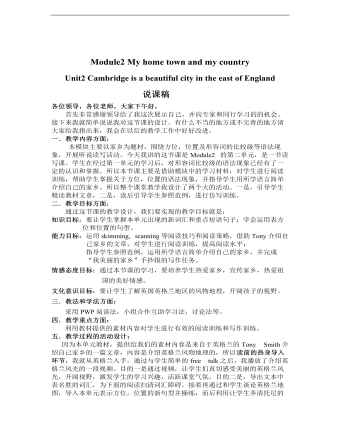
初中英语外研版八年级上册《Module 2 My home town and my countryUnit 2》说课稿
一.教学内容方面:本模块主要以家乡为题材,围绕方位,位置及形容词的比较级等语法现象,开展听说读写活动。今天我讲的这节课是Module2 的第二单元,是一节读写课。学生在经过第一单元的学习后,对形容词比较级的语法现象已经有了一定的认识和掌握。所以本节课主要是借助模块中的学习材料,对学生进行阅读训练,帮助学生掌握关于方位,位置的语法现象,并指导学生用所学语言简单介绍自己的家乡。所以整个课堂教学我设计了两个大的活动。一是,引导学生精读教材文章,二是,读后引导学生参照范例,进行仿写训练。
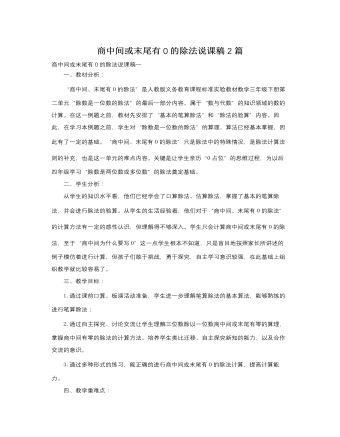
人教版新课标小学数学三年级下册商中间或末尾有0的除法说课稿2篇
教法、学法分析我通过阅读教材、教参和新课标,分析学生学习状况,认为对这一教学内容理解起来比较容易。所以,在教学时我准备采取以下策略:1、放手让学生自主解决问题,尝试计算例7的1、2题。再通过学生口述计算过程,教师设问、强调重点使学生掌握本节课知识。2、通过学生反复叙述算理,培养学生口头表达能力,并使他们自主探索“被除数中间或末尾没有0,商中间或末尾有0”这一知识形成的过程。教学目标1、在熟练掌握一位数笔算除法法则的基础上,会正确计算商中间或末尾有0的除法的另一种情况。2、能熟练地进行商中间有零和末尾有零的除法,形成一定的笔算技能。3、能结合具体情境估算三位数除以一位数的商,增强估算的意识和能力。

人教版新课标小学数学一年级上册不同标准分类的多样 说课稿
板块三:拓展延伸,促进内化。 新的教学方法是从塑造人的角度考虑。因此,课堂教学不能只局限于本课知识的教学,而应创设机会,促进知识的内化,拓展学生的思维。正因为深知这一点,本节课我设计了"森林小帮手"这一拓展练习,让学生带着成功的探索经验去思考并解决更多复杂标准的分类。这一活动既加深了学生对各类物体的认识,又培养了学生动手操作的能力,拓展了学生的思维,内化了所学知识,美化了学生的心灵和情感。还培养了学生合作创新的能力,起到一石三鸟的效果。板块四:作业延伸,还原于生活。"数学来源于生活,而又应该为生活服务。"这是《数学课程标准》强调指出的。基于本节课的内容,我设计了以下的课外作业:1、请小朋友利用今天学到的本领做一次小管家,把自己的书包、书柜、衣柜事理好。2、请同学们设想一下,如果你是当地的某大超市、商场的设计家或管理人员,你将怎么摆放物品和划分商场呢?
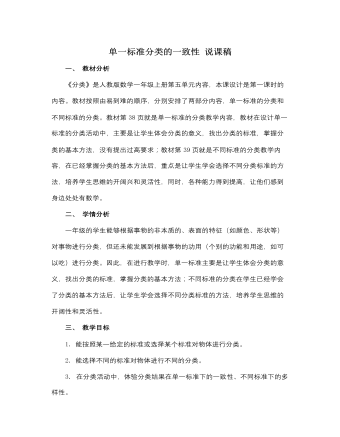
人教版新课标小学数学一年级上册单一标准分类的一致性 说课稿
同时,大大地调动起学生学生学习的热情。让学生对学具材料进行分类,可以选择不同标准(例如,可以按照学具的形状、颜色、是否立体图形等),让学生在小组合作的过程中独自按照一定的标准分类,而不是由教师提出分类依据,教师在学生回答的基础上帮助学生总结分类的依据,以此来评价孩子分类的能力。板块四:巩固应用,拓展延伸数学来源于生活,生活中又充满数学。在本课最后一环节,让学生说说在生活中可以运用本课所学知识做些什么,拓展了学生的思维。让学生整理自己的书包,进一步巩固体验分类的方法,让数学走进生活,让学生在生活中看到数学,接触数学,培养了学生的探索精神和创新意识。整节课的设计贴近生活,目的是激发学生的兴趣。并且体现《课标》中数学知识生活化的要求。让学生感受到生活中处处有数学知识。结合具体情境使学生掌握的知识层层深入,最后达到灵活运用的程度。
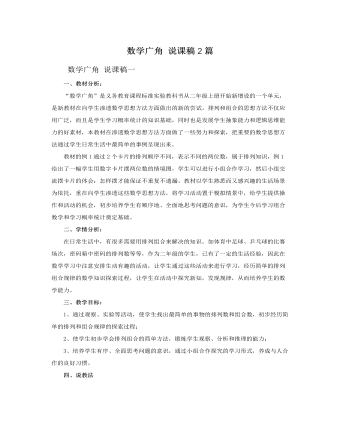
人教版新课标小学数学二年级上册数学广角 说课稿2篇
对比分析为什么刚才咱们从不同的3个数字中选出两个,可以摆成6个不同的两位数,而现在三个同学每两个握一次手,就一共只握了3次呢?(学生讨论,发表意见)(握手不存在调换位置的情况,跟顺序无关,而排列数,位置调换就变成另一个数,与顺序有关。)三、实践应用,巩固新知师引导:同学们今天说得太精彩了!那我们就进数学广角痛痛快快地玩玩吧!(出示课件)问:进去吗?(再次打开课件,欣赏)1、快乐狗活动室(练习二十三第2题)质疑:咦,机灵猫,兰兰他们去哪了?呵,机灵猫猫想要运动运动,就来到了快乐狗活动室。(课件展示)机灵猫就是机灵猫,看他们打球还想到问题了:如果每两个人打一场乒乓球比赛,他们三人一共要打多少场比赛呢?谁能很快说出来!(学生分析,指名说说)2、小喜鹊超市(练习二十三第1题)
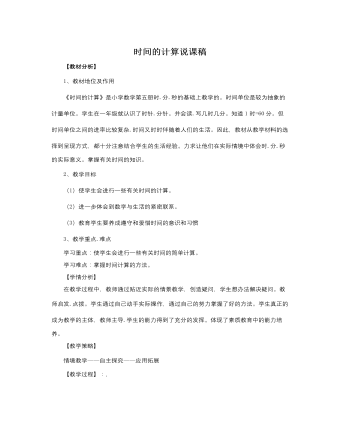
人教版新课标小学数学三年级上册时间的计算说课稿
【反思】本节课的教学注重体现了情境教学在教学中的运用。课堂上体现了这样几个特点:1.数学知识与生活实际相结合。数学来源于生活,生活中处处有数学。小学生对熟悉的生活情境和事物感兴趣。所以我从他们熟悉的事物中寻找教学题材,设计了有趣的情景教学。让学生感到数学知识就在他们身边,感到数学的作用,设计了作息时间表。这样,既巩固了时间的知识。又可以教育学生在生活中要合理安排时间,不要浪费时间,做时间的主人。2.注重在学习中自主探究,合作交流。在教学《时间的计算》时,让学生用自己制作的学具表亲自动手拨一拨,想一想让他们主动尝试自主发展。教学例2时让他们小组合作交流学习方法。这些都体现了培养学生的能力.自主探究的精神。
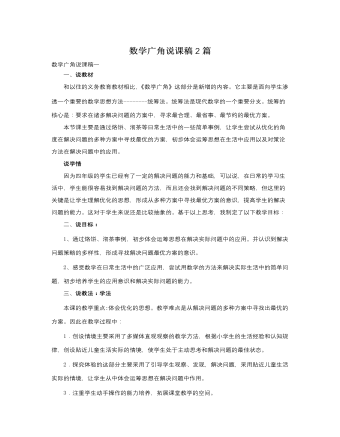
人教版新课标小学数学三年级上册数学广角说课稿2篇
三、说教学理念:通过观察、猜测及动手操作实验等方法,向学生渗透有序的数学思想。四、说教学过程:一、创设情境、激趣导入。小朋友们喜欢什么样的球类运动呢?让学生各抒已见。当有人说到足球时。老师马上引到学校冬季运动会,我们三年级3个班的比赛情况,结果我们班得了第一。那我们班比赛了几场?学生回答两场。三个班比赛,每两个班比赛一场,那一共要比赛多少场呢?四人小组合作完成。然后汇报,并说理由。二.动手实践,自主探究1.2002年世界杯足球C组比赛有几国家?是哪几个国家?让学生发表意见。他们说不出,老师再告诉他们。2.如果这四个队每两个队踢一场球,一共要踢多少场?(课件演示主题图)3.让学生大胆说一说、猜一猜。4.四人小组用学具卡片摆一摆、讨论讨论。
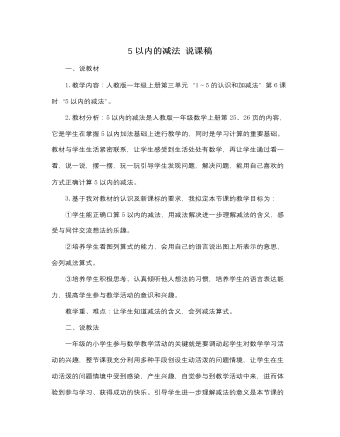
人教版新课标小学数学一年级上册5以内的减法 说课稿
一年级的小学生参与数学教学活动的关键就是要调动起学生对数学学习活动的兴趣,整节课我充分利用多种手段创设生动活泼的问题情境,让学生在生动活泼的问题情境中受到感染,产生兴趣,自觉参与到教学活动中来,进而体验到参与学习、获得成功的快乐。引导学生进一步理解减法的意义是本节课的重点,用肢体语言演示让学生扎扎实实的掌握3个方面的知识点:第一点要会说,能从图中找到与数学有关的信息,并能恰当地提出一个问题;第二点会数,能准确地数出原来有多少、去掉几个就是减几,去掉的这个数是从总数里去掉的;第三点会列算式,并让学生在此基础上创造性的根据算式来编一个故事,并提出问题,让学生在不知不觉中学会了举一反三,从而做到一通百通。 本节课我始终遵循这样一个教学原则,即知识的起点由低到高,由易到难,循序渐进,一步一步逐渐引导学生做到举一反三,一通百通。 三、说学法 这部分内容的学习适于学生展开观察、操作、交流等教学活动。为了更好地指导学法,我采用合作形式组织教学。这样,一方面可以让学生自己去发现,体验创造的过程;另一方面,也可以增强学生的合作意识,在互动中迸出智慧的火花。
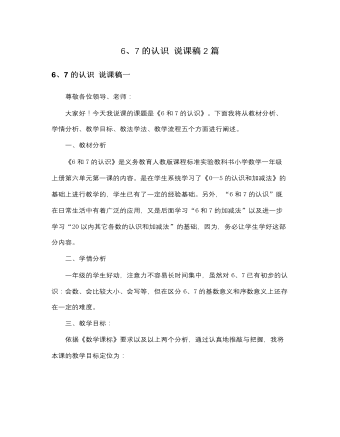
人教版新课标小学数学一年级上册6、7的认识 说课稿2篇
新《课程标准》中指出:“数学教学是数学活动的教学,是师生之间、生生之间交往互动与共同发展的过程,数学教学应从学生的实际出发,创设有助于学生学习的问题情境,引导学生思考、探索、交流、获得知识,形成技能,发展思维,学会学习,促使学生在教师指导下主动地、富有个性地学习。”整节课以动画人物情境贯穿于始终,充分调动学生学习的积极性和主动性,来完成本课的教学任务。上课伊始我播放一首学生熟悉的动画片《虹猫蓝兔七侠传》的片头曲《人生不过一百年》,创设教学情境,贴近学生的生活,自然引出7个动画人物。不仅复习了1—5,而且顺利引出新课。接下来的探究新知阶段,继续以为七剑合壁解决困难为情境线索,将新知自然呈现在学生的面前,使学生通过自主、合作探究的学习方式,完成6和7的数数、认数、数序、比较大小、序数意义以及书写的学习。
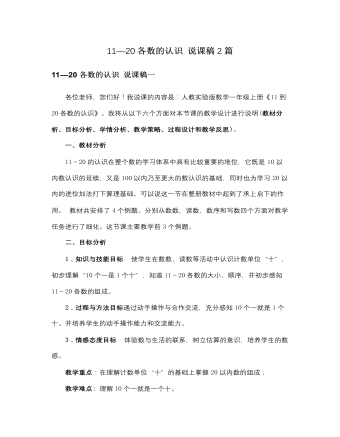
人教版新课标小学数学一年级上册11—20各数的认识 说课稿2篇
(二)自主探究,学习新知。(1)认识“11”。让学生说说身边的“11”,接着数出11根小棒。根据学生已有的知识和经验,猜想学生能顺利地数出;再接着让学生另外数出11根小棒,动手摆一摆,探讨一下还有没有别的更好的摆法。比较各种摆法的不同点。[在学习新知,突破重难点这一环节,让学生动口说一说,动手摆一摆,用眼观察,用脑思考,使学生通过具体实物比较各种摆法,让学生借助实物感知10根一捆的原因,建立以一代十的表象认知。](2)学习例2中的“15、20”,加深理解组成。让学生数出15根小棒,动手摆一摆,捆一捆。引导学生运用上面发现的容易看出数量的方法,摆一摆,捆一捆,同桌交流,互相猜猜,根据实物说出数量,根据实物说数的组成,再倒过来根据组成说出这个数。如:“15是由1个十和5个一组成,1个十和5个一组成15。”同样,让学生动手摆摆,捆捆,看看,说说,学习“20”。
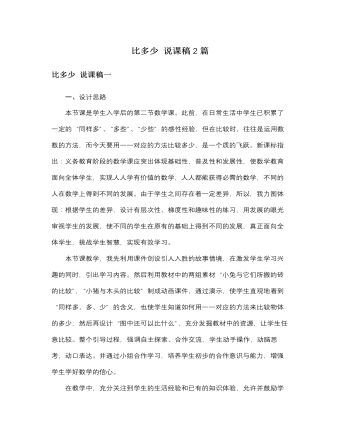
人教版新课标小学数学一年级上册比多少 说课稿2篇
本节课是学生入学后的第二节数学课。此前,在日常生活中学生已积累了一定的“同样多”、“多些”、“少些”的感性经验,但在比较时,往往是运用数数的方法,而今天要用一一对应的方法比较多少,是一个质的飞跃。新课标指出:义务教育阶段的数学课应突出体现基础性,普及性和发展性,使数学教育面向全体学生,实现人人学有价值的数学,人人都能获得必需的数学,不同的人在数学上得到不同的发展。由于学生之间存在着一定差异,所以,我力图体现:根据学生的差异,设计有层次性、梯度性和趣味性的练习,用发展的眼光审视学生的发展,使不同的学生在原有的基础上得到不同的发展,真正面向全体学生,挑战学生智慧,实现有效学习。本节课教学,我先利用课件创设引人入胜的故事情境,在激发学生学习兴趣的同时,引出学习内容。
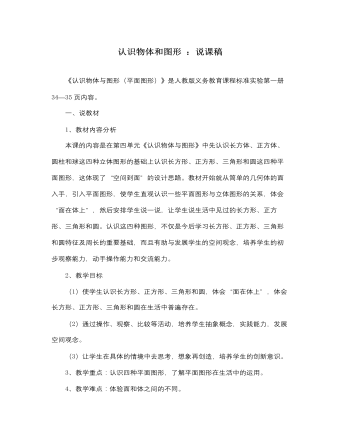
人教版新课标小学数学一年级上册认识物体和图形 说课稿
(二)师生互动,认识长方形、正方形、三角形和圆。1、学生拿出准备好的学具(长方形、正方形、等)亲自动手实践,摸一摸、看一看,并在纸上描画这些物体的面,比一比哪个小组的同学画得最好。2、分组讨论,教师巡视3、全班交流,展示作品,根据学生的交流,师生共同得出结论,长方体画出的是长方形,正方体画出的是正方形,三角锥画出的是三角形,圆柱画出的是圆。4、联系生活说一说,清学生说一说生活中见到哪些物体的面是长方形、正方形、三角形和圆。(三)巩固练习用准备好的学具(若干个)拼出自己喜欢的图案,看哪个小组在规定的时间内拼得图案最多最美。1、小组活动。2、各个小组展示自己的作品。3、小组评价,选出优胜品。师选出几个有代表性的作品,让学生分析它是由什么图形组成。

